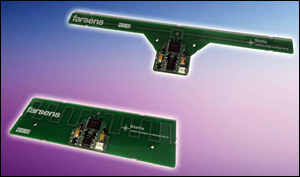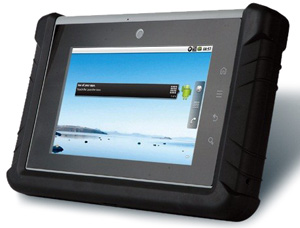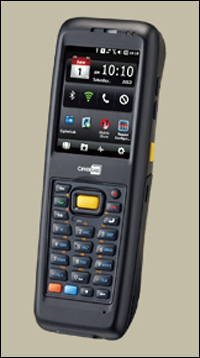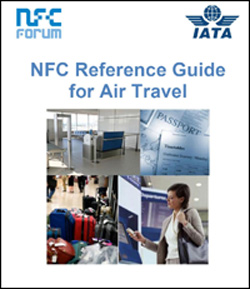The following are news announcements made during the past week by the following organizations: CISC Semiconductor; Farsens; IDTronic; CipherLab; Omni-ID; NFC Forum; IATA; and IDTechEx.
CISC Semiconductor Launches Next-Gen UHF RFID Test System
Austrian design and consulting service firm CISC Semiconductor has announced updates to its CISC RFID Xplorer system for testing the performance of ultrahigh-frequency (UHF) RFID tags. First unveiled in April 2012 (see RFID News Roundup: CISC Unveils Portable UHF Tag Test System), the Xplorer is a portable, compact solution specifically designed as a cost-effective, small and powerful measurement system for RFID tag sensitivity, communication range and backscatter measurements, according to the company. The new version—known as the Xplorer 200—has extended read and write memory tests and test support for crypto suites fully supporting EPCglobal and ISO/IEC test standards, among other features. Xplorer 200, which will be unveiled next week in booth #12 at the RFID Journal LIVE! Brasil conference and exhibition—to be held on Nov. 6-7 in São Paulo—is also developed to meet all Brazilian RFID test standards, such as SINIAV, ARTESP and Brasil ID. Xplorer can be used to measure both standalone tags and those applied to products, the company reports, and is also able to perform a complete analysis of multiple tags. With dimensions of 160 millimeters by 205 millimeters by 50 millimeters (6.3 inches by 8.1 inches by 2 inches), the CISC RFID Xplorer can be easily transported, and dismantling and setup can be accomplished within minutes, CISC Semiconductor claims. The device operates within a frequency range of 800 MHz to 1 GHz, and the measurement speed achieved, using an appropriate computer running the Xplorer measurement software, is less than 1 second per frequency, the company says. During reader performance and conformance tests, the signal was transmitted in real time with no recording time limitation. Xplorer is designed for open-area tests, and as a solution for measurements within an RF-controlled environment using portable or fixed RF test chambers. The system is supplied with software and a reference tag for self-calibration. The test equipment is controlled using a graphical user interface (GUI) with an additional application programming interface (API) for the development of user-defined test sequences within standard development environments.
Farsens Unveils Passive RFID Tag With LED
Farsens, a provider of passive RFID-enabled sensor technology and wireless sensor networks, has introduced a battery-free RFID tag that includes a light-emitting diode (LED) that flashes when a tagged item is located. The LED on the Stella RFID tag is designed to make it easier for users to visually identify items when conducting inventory counts or other processes, Farsens explains. A user simply inputs the desired unique ID into the reader software, and only the tag with that ID will flash its LED, enabling the user to easily detect it and pick it up, the company reports. The tag works with any commercial EPC Gen 2-compliant readers. When the reader requests a specific ID number, the Stella will flash its LED if it is within read range. The Stella has a 96-bit Electronic Product Code (EPC) memory, a 32-bit tag identifier (TID) and a password-protected kill command. Built in a PCB format, it is available in various sizes: 135 millimeters by 30 millimeters (5.3 inches by 1.2 inches), with a dipole wideband antenna that works at both the 868 MHz and 915 MHz frequency bands; 149 millimeters by 29 millimeters (5.9 inches by 1.1 inches), with a dipole 868 MHz antenna for the 868 MHz frequency band; and 82 millimeters by 28 millimeters (4.2 inches by 1.1 inches), with a meander 868 MHz antenna for the 868 MHz frequency band. The read range is up to 1.5 meters (4.9 feet) and the operating temperatures range from -30 degrees to +85 Celsius (-22 degrees to +185 degrees Fahrenheit).
IDTronic Announces New Industrial RFID Tablet, Adds NXP Chips to Variety of Products
IDTronic has added to its portfolio of mobile RFID terminals the Robo Tablet PC, an industrial device able to withstand the effects of rain and a fall from 1.2 meters (3.9). The device includes a 13.56 MHz RFID reader (compliant with the ISO 14443A, ISO 15693 or ISO 18092 standards) for data acquisition, the company reports. Weighing 1.1 kilograms (2.4 pounds), the Robo is designed for such applications as industrial maintenance and inspections in a variety of industries, including transportation, storage, logistics, retail, automation, production, emergency medicine, data acquisition and distribution. The Robo has an IP 64 rating, ensuring its protection against harsh conditions, and features a 1 GHz ARM Cortex Processor, 4 GB of flash memory, 512 megabytes of SDRAM memory, an Android 4.1.2 operating system, two hot-swap batteries, a 2-megapixel front camera, a 4-megapixel back camera, two USB ports, GPS, a 1D laser/2D bar-code scanner and imager, and Bluetooth 4.0, Wi-Fi 802.11b/g/n and 3G radios for wireless connectivity. Its LCD touchscreen measures 7 inches and includes light-emitting diode (LED) background lighting. A headset input and integrated speakers allow for real-time communication, according to the company. IDtronic has also announced that all of its key fobs, cards, labels and wristbands are now available with the current versions of NXP Semiconductors‘ Mifare DESFire chips and NTAG203 NFC chip.
CipherLab Announces 9200 Series Industrial Mobile Computer With RFID
CipherLab USA has unveiled its new 9200 series industrial mobile computer with a variety of data capture options, including a reader for high-frequency (HF) RFID 13.56 MHz tags compliant with the ISO 14443A (Mifare), ISO 14443B and ISO 15693 standards. The mobile computer also includes options for a linear imager, a laser and a 2-D imager. The 9200 series mobile computer has a certified IP rating of 65, meaning that testing has confirmed it to be dustproof and waterproof, and a 1.5-meter (4.9-foot) drop resistance, ensuring its ruggedness. The device includes 3.5G HSDPA, with GPS/AGPS options for data transfer and location information. Its networking support provides for real-time data transmission, featuring Cisco CCX v4-certified IEEE 802.11 a/b/g/n technology, as well as support for Bluetooth communication 2.1 for full compatibility with Bluetooth peripherals. It also uses long-lasting 3300 mAh batteries, which CipherLab says minimizes the need to change batteries, while also allowing for easy data-capturing for extended lengths of time.
Omni-ID Selects Mieloo & Alexander as Integrator for ProView Installations in Europe
RFID supplier Omni-ID has announced that it has selected Netherlands-based automatic-identification specialists and logistics consultancy firm Mieloo & Alexander to implement Omni-ID’s ProView visual tagging system at a number of manufacturing facilities throughout the United Kingdom, Benelux and Germany. Omni-ID declines to name any specific manufacturers yet, but says they are primarily in the automotive industry. The ProView system combines a bistable LCD screen with Omni-ID active and passive ultrahigh-frequency (UHF) RFID transponders; the technology won last year’s RFID Journal Award for Best in Show at RFID Journal LIVE! 2012 (see RFID Issues Instructions On the Fly). The applications that Mieloo & Alexander are deploying are primarily work-in-process (WIP), the company reports, and the tags will replace paper labels or instructions (kanban cards) affixed to carriers and totes. The solution will provide automated tracking and dynamic visual interaction with operators via each tag’s rugged e-paper screen. The ProView system will provide track-and-trace capabilities for the carriers and totes, in addition to providing the WIP instructions. Additionally, Omni-ID indicates, the system will provide the ability to drive a multitude of business analytics for enhanced reporting, in order to drive overall process improvements. According to the company, none of its partners or other third-party integrators have previously implemented the ProView solution—only Omni-ID has. Businesses already using the ProView system include Whirlpool, in the United States (see Whirlpool Adopts RFID for Parts Identification). But demand for ProView’s capabilities is growing, according to Omni-ID, and so it needed an installation partner. Omni-ID has been working with Mieloo & Alexander for years, and the two partners have already undertaken a number of large-scale passive deployments together; in addition, Omni-ID notes, Mieloo & Alexander focuses on supply chain improvement, proven project delivery and systems expertise in the auto-ID industry, making it an ideal partner. According to Omni-ID, the company is currently working with Mieloo & Alexander on several projects for ProView that are still in the planning and development phases.
NFC Forum and IATA Publish NFC Reference Guide for Air Travel
The NFC Forum, a nonprofit industry association working to advance the use of Near Field Communication (NFC) technology, and the International Air Transport Association (IATA), a trade group comprising airlines around the globe, have announced the publication of the “NFC Reference Guide for Air Travel.” The two organizations—specifically, the NFC Forum’s Air Transport Task Force and IATA’s Fast Travel Working Group—collaborated to develop content for the document, which is designed to help the global air-travel industry better understand and evaluate the potential benefits and costs, use cases, and implementation options associated with the adoption of NFC technology. The white paper describes how the airline industry can employ NFC technology for a variety of applications, including for the secure provisioning, storage, and reading of boarding passes on mobile devices, as well as tap-and-go access to elite lounges and other areas, luggage handling, parking garage access and payment. IATA’s members contributed expertise about requirements for the technology’s use in various aspects of air transport, while NFC Forum’s members provided details regarding implementation options and practical information about existing applications, according to the two organizations. There is an extensive section detailing why IATA members should adopt NFC, citing such aspects as self-service functions enabling faster throughput of passengers through airports, speedier and more efficient boarding, the reduction in paper boarding passes that is moving the industry toward “paperless travel,” and the fact that NFC readers are much more affordable than optical readers, have a much smaller form factor, and are more reliable (98 percent minimum read success versus 93 percent for optical). The report discusses a variety of other potential use cases for NFC as well, and includes a detailed comparison chart outlining different NFC implementation options. A section devoted to return on investment (ROI) describes how deploying NFC technology among mass-transit operators has resulted in cost savings in the areas of printed tickets, mechanical kiosks and customer service agents, in addition to increased revenues from return customers, and expansion into co-located and related businesses. The white paper can be downloaded for free at the NFC Forum’s Web site.
IDTechEx Predicts Global RFID Market to Reach $7.88 Billion in 2013
The global RFID market—including tags, readers and software or services for RFID cards, labels, fobs and all other form factors—will increase from $6.98 billion in 2012 to $7.88 billion, and will reach $23.4 billion in 2020, according to new research from IDTechEx. In total, IDTechEx finds that 5.9 billion tags will be sold this year, versus 4.8 billion in 2012. The findings are part of IDTechEx’s report, titled “RFID Forecasts, Players & Opportunities 2014-2024.” The market research firm reports that much of the consolidation and growth in the ultrahigh-frequency (UHF) market has been driven by retail apparel applications, which will demand 2.24 billion RFID labels by the end of 2013. After apparel tagging, passive UHF is deployed in many different application areas for asset tracking and other applications; according to IDTechEx, these are small volumes, but add up to hundreds of millions of tags annually, given the strong payback they provide to users. IDTechEx expects 3.1 billion passive UHF RFID tags to be sold in 2013. Although passive UHF tags are selling more passive high-frequency (HF) (this happened for the first time in 2012, according to IDTechEx), the money spent this year on passive UHF tags will be $247 million, versus $2.15 billion on HF and $713 million on low-frequency (LF) tags. The higher value of HF and LF tags, the firm notes, is due to a variety of RFID tags in high-value applications, including animal tagging, contactless smart cards and passports. The report also finds that while there will be an opportunity in the coming years for a billion-dollar RFID leader or two to emerge (given the fact that it is currently a nearly $8 billion market), no one is yet hitting even half of that in revenue. Of the 800 or so suppliers, IDTechEx only counts eight as having revenues of more than $100 million, and fewer than 20 with sales between $20 million and $100 million.





